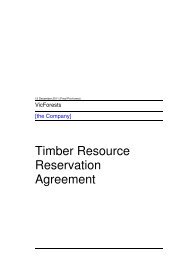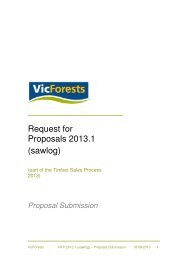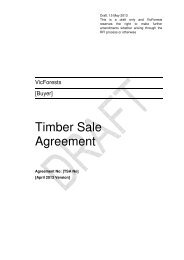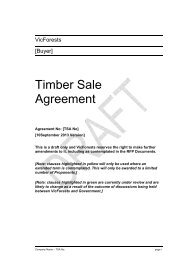Module 5 - VicForests
Module 5 - VicForests
Module 5 - VicForests
You also want an ePaper? Increase the reach of your titles
YUMPU automatically turns print PDFs into web optimized ePapers that Google loves.
Comment<br />
Ref<br />
Page Coupe General Comments Auditors consideration<br />
Page Coupe Coupe Specific Comments<br />
12 20 C6 This is a temporary stream, not a permanent stream, and therefore the 20m<br />
buffer is additional to the requirements. See documentation provided.<br />
The Auditor agrees that this waterway is a temporary stream and therefore does not<br />
require a 30m buffer. This non-compliance has been removed.<br />
13 22 C15 The audit found this coupe to have more than 10% of the area greater than<br />
30 degrees. <strong>VicForests</strong> would like to know how was this value calculated as<br />
our GIS data shows that C15 has less than 10% harvested over 30 degrees.<br />
Contractor rates are affected by slope and rock and contractors are quick to<br />
alert <strong>VicForests</strong> if a coupe exceeds 30 degrees over any significant area.<br />
See documentation provided.<br />
The assessment was based on visual assessment during the coupe inspection. This noncompliance<br />
has been removed, based on GIS slope analysis data provided by <strong>VicForests</strong>.<br />
14 34 C3 Topsoil not road construction fill was stockpiled on the edge of the road for<br />
use in rehabilitation of the road. An active coupe is currently using the road<br />
and it will be rehabilitated when use of the road is no longer required. There<br />
is no evidence of erosion or impact on the rainforest. DSE is aware of the<br />
planned rehabilitation activities and that the road will be rehabilitated once<br />
access is no longer required. We do not believe this should be a major noncompliance<br />
as there are plans in place to use the topsoil to rehabilitate the<br />
road<br />
The stockpiled soil appears to be subsoil rather than topsoil, however discussions with a<br />
local senior DSE officer with knowledge of the issue, during the 'comments on matters of<br />
fact' period advised that it is both topsoil and subsoil. Erosion of the soil stockpiles was<br />
visually evident during the site inspection and evident in the photo included in the audit<br />
report.<br />
The DSE officer advised the Auditor that <strong>VicForests</strong>, at the time of road construction, had<br />
discussed with DSE options to minimise disturbance to the several wet gullies that the<br />
road crosses. The DSE officer advised that it was verbally agreed that the best option<br />
would be to stockpile topsoil in order to rehabilitate (including ripping and spreading of<br />
topsoil) the road after completion of harvesting in an adjacent coupe, which also used the<br />
road. He also advised that the stockpiling of the soil against the trees was agreed as the<br />
option of least impact, compared with increasing the clearing width. However, these<br />
decisions were not documented and plans were not developed and authorised.<br />
14 continued 14 continued from above Based on this limited information, the Auditor acknowledges the apparent consideration<br />
that was given to various options to minimise impact and that <strong>VicForests</strong> plans to<br />
rehabilitate the road to a higher level than the minimum required. In light of this<br />
information, the Auditor considers that the main deficiency appears to be in documenting<br />
plans and obtaining approvals for this work, given that the activities have resulted in<br />
outcomes not aligned with the Code and Management Procedures (soil stockpiles not<br />
appropriately stabilised, soil stockpiled against live trees). The Auditor has reviewed the<br />
assessment of this issue in light of the apparent planning that has been undertaken with<br />
the aim of minimising environmental impact and based on this inf ormation, that the impact<br />
is likely to be medium term (12-36) months rather than long term (>36 months).<br />
Therefore, the EIA has been reduced from Major to Moderate and recommends that, when<br />
complete, the rehabilitation of this road, including timeliness of rehabilitation, be reviewed<br />
by DSE as the regulator, against what was said to have been agreed.<br />
15 37 C23 The report states that the auditor considers that the loading bays should<br />
have been managed as landings and rehabilitated accordingly, but has the<br />
loading bay from the thinning operations increased in size Our<br />
prescriptions outline that loading bays require rehabilitation according to<br />
landing requirements if they exceed 600 square metres. The nonrehabilitation<br />
of these areas is no different, in this clearfall situation, from<br />
that of a final cut following a thinning. If the auditors sees this as an area of<br />
improvement, it should be a recommendation not a non-compliance.<br />
16 38 C2 The Management Procedures do not state if topsoil should be spread before<br />
or after ripping. The Utilisation Procedures states that topsoil should be<br />
spread after ripping unless otherwise directed by a <strong>VicForests</strong><br />
representatives. This was authorised by <strong>VicForests</strong> staff, on these coupes,<br />
as discussed in the field, due to compaction while spreading topsoil<br />
38<br />
continu<br />
ed<br />
Continued from above<br />
17 38 C3 The Management Procedures do not state if topsoil should be spread before<br />
or after harvesting. The Utilisation Procedures states that topsoil should be<br />
spread after ripping unless otherwise directed by a <strong>VicForests</strong><br />
representatives. This was authorised by <strong>VicForests</strong> staff, on these coupes,<br />
as discussed in the field, due to compaction while spreading topsoil.<br />
18 38 C4 The Management Procedures do not state if topsoil should be spread before<br />
or after harvesting. The Utilisation Procedures states that topsoil should be<br />
spread after ripping unless otherwise directed by a <strong>VicForests</strong><br />
representatives. This was authorised by <strong>VicForests</strong> staff, on these coupes,<br />
as discussed in the field, due to compaction while spreading topsoil.<br />
19 38 C5 The Management Procedures do not state if topsoil should be spread before<br />
or after harvesting. The Utilisation Procedures states that topsoil should be<br />
spread after ripping unless otherwise directed by a <strong>VicForests</strong><br />
representatives. This was authorised by <strong>VicForests</strong> staff, on these coupes,<br />
as discussed in the field, due to compaction while spreading topsoil. We<br />
believe these should not be non-compliances as they comply with our<br />
requirements<br />
Agreed that a final cut following a thinning is effectively the same as a clearfall operation<br />
in terms of stocking result. Non-compliance has been removed. One loading bay area<br />
was larger than 600 square metres (700 square metres), however the area also<br />
incorporated a turnaround for trucks.<br />
The Utilisation Procedures state that topsoil should be spread after ripping and the<br />
Silvicultural Guidelines #11 recommend that topsoil be spread after ripping. The Auditor<br />
agrees that the UPs include a statement that this can be varied if directed by a <strong>VicForests</strong><br />
representative. This direction was not documented, however the Auditor agrees there is<br />
no specific requirement that documentation is required. Therefore the reference to<br />
respreading topsoil has been altered, however the non-compliances remain in that they<br />
are due to the landings having an insufficient cover of topsoil.<br />
Text has been changed to: On four coupes (C2, C3, C4 and C5), topsoil had been<br />
replaced before landings were ripped. The relevant procedural documents recommend<br />
that topsoil be spread after ripping, but there is provision for the Forest Officer to vary this<br />
practice. <strong>VicForests</strong> staff stated that the decision to spread topsoil before ripping on<br />
these coupes was taken in response to landing compaction through ripping after topsoil<br />
replacement. The Auditor considers that this practice is likely to have contributed to the<br />
lack of topsoil on the rehabilitated landings, but acknowledges the operational challenges<br />
of achieving both alleviation of compaction and replacement of topsoil, particularly on<br />
soils where there is a naturally thin layer of topsoil.<br />
as above<br />
as above<br />
as above











